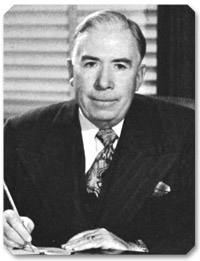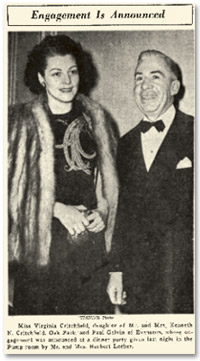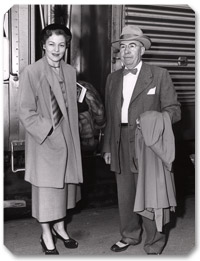|
CHAPTER TWO By the time Paul Galvin and Virginia Critchfield met in November 1944, the world was in its fifth hellish year of war. Americans got by on strict wartime rationing, and an unprecedented eight million American women worked outside the home, primarily in secretarial and teaching positions. Bing Crosby's "White Christmas" was a popular holiday song, the musical Oklahoma! had debuted on Broadway, and Walt Disney's animated film feature, Bambi, was a box-office smash. Across the Atlantic, underground French Resistance fighter Albert Camus' novel, The Stranger, was published; the uprising in the Warsaw Ghetto had failed tragically; and leaders from Russia, the United States, and Britain met to strategize the defeat of Hitler's Third Reich. President Franklin D. Roosevelt would die unexpectedly in 1945; Italy's fascist dictator, Benito Mussolini, would be deposed and executed; and Adolf Hitler, rather than concede defeat, would commit suicide. In May 1945, six months before Paul and Virginia's wedding, Germany surrendered. One month later, in June, the United Nations charter was formed, and on August 6 and 9, President Harry S. Truman ordered atomic bombs dropped on Hiroshima and Nagasaki, bringing an end to World War II, which had lasted six years. Over fifty million lives had been lost, and much of Europe was in economic and physical ruin. Ironically, by the end of the worst war the world had ever seen, the American economy was robust, the United States was in possession of the world's deadliest weapon, and a new era ushered in American prosperity, stability, and global power. When forty-nine-year-old Paul V. Galvin walked into Dr. Greenwood's office in the Pittsfield Building on Wabash and Washington in Chicago in the fall of 1944, the medical receptionist who greeted him could never have guessed that this man would transform her future. Nor could Paul have guessed the happiness Virginia would bring him after years of hard-won public success and a steady accumulation of personal sorrows. Born in the small farm town of Harvard, Illinois, on June 29, 1895, Paul Vincent Galvin was the son of an Irish bartender, and the oldest of five children. At an early age, Paul showed an entrepreneurial flair, selling popcorn to passengers on trains stopping in Harvard. After dropping out of college because of his family's economic hardship, Paul joined the army from 1917 to 1919, and on April 24, 1920, he married Lillian Guinan, his high school sweetheart. With a resolute, near-obsessive belief in hard work and the value of plain common sense, Paul started a battery company in Marshfield, Wisconsin. On October 9, 1922, his only child, Robert "Bob" William Galvin, was born. When his battery business failed, Paul joined the Brach Candy Company in Chicago as the personal secretary to Emil Brach from 1923 to 1926. Recognizing that national radio sales were booming, Paul left Brach to found the Galvin Manufacturing Corporation in 1928 and soon found himself weathering the deaths of his mother-in-law in August 1929, his father on October 3, and his mother on December 9. In the midst of these deeply personal losses came the stock market crash on October 29. Despite all of this, Paul managed to succeed in his ambition to be the first to install radios in automobiles. With his wife Lillian and seven-year-old son Bob, Paul drove to Atlantic City in June 1930 to attend the Radio Manufacturers Association convention. The long drive served as a practical road test for the newly installed radio in his car. Once in Atlantic City, Paul launched his brand-new car radio business with the trademark, "America's Finest Car Radio." The word motorola,which would eventually be used in the famous trademarks of Motorola Radio and Motorola, Inc., and which suggested both motion and radio,occurred to Paul spontaneously one morning in 1930, while he was shaving. The phenomenal success Paul Galvin eventually attained was not without its persistent challenges, failures, and obstacles. Paul, however, had a relentless drive to succeed. He knew how to turn failure into potential inspiration and was fortunate to have the unceasing support of his wife, Lillian, and his brother, Joseph, who both selflessly helped Paul to run his early business with honor, integrity, and efficiency. In Harry Mark Petrakis's biography of Paul Galvin, The Founder's Touch, Paul's resilient ability to recover from losses and problems and proceed to new success is described in incident after incident. In addition, he treated his Motorola employees, in their initially small numbers and later into the thousands, with fairness and equality, inspiring a legendary loyalty among them and maintaining one of the only American companies whose workers voluntarily refused unionization. His employees could purchase Motorola stock, their healthcare benefits were excellent, and it was not uncommon for Paul personally to make sure an employee or member of his family received proper medical treatment. Paul Galvin inspired unwavering allegiance in his closest friends and employees, and his ethic of hard work, nondefeatism, and fairness, coupled with a kind of sixth sense,a visionary ability to think innovatively and with an eye toward the future,brought him wealth, influence, and a philanthropic reputation. |
|
| About the Author l Pipertrust.org | |










